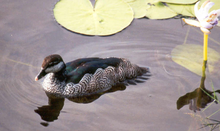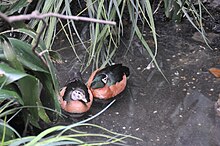Dwarf ducks
| Dwarf ducks | ||||||||||||
|---|---|---|---|---|---|---|---|---|---|---|---|---|

Coromandel pygmy duck on a body of water in Kolkata, India |
||||||||||||
| Systematics | ||||||||||||
|
||||||||||||
| Scientific name | ||||||||||||
| Nettapus | ||||||||||||
| Brandt , 1836 |
The pygmy ducks ( nettapus ) are a genus of duck birds and are assigned to the swimming ducks . The genus includes three tropical species that are native to Australia, Southeast Asia, and Africa and Madagascar. They are among the smallest species of duck in the world. The Indian pygmy duck , the nominate form of the Coromandel pygmy duck native to Asia , is considered the smallest duck of all.
Appearance
Little ducks reach a height between 27 and 37 centimeters. They are very compact ducks with a short beak. In the African pygmy duck , the beak goes very straight into the forehead. The resulting wedge-shaped head profile is reminiscent of that of geese, which has led to the name Pigmy Goose in English . The head profile of the other two species, the Coromandel pygmy duck and the Australian pygmy duck , on the other hand, is more rounded. All three species have relatively short legs. They are therefore not particularly agile on land. They spend the majority of their lives on the water.
The males of the Coromandel pygmy duck have predominantly pale body plumage. What is striking about her is the dark chest band, which is clearly separated from the rest of the light body plumage. The coat plumage is greenish in them. The green back coloration of the males is more pronounced in the Australian pygmy duck. The flanks are noticeably scaled. The African pygmy duck has the most colorful plumage. Her flanks and chest are a bright, light chestnut brown. The powder-green, black-edged facial spot, which also plays a role in the courtship repertoire, is striking.
The females basically have a somewhat more inconspicuous body plumage. With them, brownish and gray-brown shades predominate. In all three species, the females have a gray-brown eye stripe. The young birds are similar to the females, but have larger proportions of brown in their plumage more regularly.
Distribution area
Little ducks are tropical ducks. Its distribution area includes sub-Saharan Africa, the Indian subcontinent, Southeast Asian archipelagos such as Borneo and Java , southern China, New Guinea and Australia.
The Australian pygmy duck, which has its distribution focus in the tropical north of Australia and New Guinea, has the smallest range in terms of flatness. Their range overlaps in northeast Queensland with the Coromandel pygmy duck. The distribution area of this species stretches from the Indian subcontinent via Sri Lanka and the south of China via the Andamans, the north of the Philippines, Borneo, Sumatra, Java, Sulawesi and the north of New Guinea as well as the northeast of Australia. However, wanderers of this kind also regularly reach Bahrain and Oman.
The African pygmy duck does not have any overlap in the range with the other two species. Their distribution ranges from Senegal and Ethiopia to the eastern subtropical regions of the Republic of South Africa. It also occurred in Zanzibar in historical times and is a breeding bird on the island of Pemba . Madagascar is also part of its range, where it is particularly common in the western and northern lowlands.
The numbers of pygmy ducks are not very high. In their area of distribution they are usually only sparse.
Habitat and food
All three species prefer calm fresh waters with rich floating vegetation. Both the Australian and the African pygmy ducks predominantly use waters filled with water lilies. They also accept very small bodies of water. In Asia, for example, the Coromandel pygmy duck can often be seen on park and pond temples, provided they have sufficient aquatic vegetation.
All three species rest hidden in the floating vegetation during the day. Although their plumage is sometimes very rich in contrast, they can hardly be seen between the leaves. They take their mainly plant-based food from the surface of the water. The extent to which the African pygmy duck also finds its food while diving is controversial in the literature. In captivity, it has also been observed that females of the African pygmy duck bend plant stems with seed heads down to the surface of the water and call the male to eat. This behavior has also been observed at least once in wild African pygmy ducks. Water lily seeds play a very important role in the food composition of the Australian and African pygmy ducks. Changes in the floating plant vegetation due to introduced fish species such as tilapia (in Africa and Madagascar) or even a change in the vegetation composition due to introduced water buffalo (Australia) lead to a decline in the number of individuals.
Reproduction
None of the three types has an extensive and striking repertoire of courtship gestures. The pair bond seems to exist in all three species over several reproductive periods. The male plays a role in guiding the chicks. However, the female alone breeds. Tree holes are preferred as nesting sites. The trees are mostly in the immediate vicinity of the water. The Coromandel pygmy duck also uses buildings for its brood. The African pygmy duck occasionally builds its nest in the dense reed bed. She also uses abandoned hammerhead nests for her brood.
Keeping in human care
Little ducks are extremely delicate fosterlings, which are therefore rarely shown in zoos or kept by private individuals as ornamental poultry. There have been holding attempts since the 1930s. Usually the ducks did not survive the acclimatization period. In the second half of the 20th century, the options for keeping ducks and the options for offering the ducks special feed improved. The Vogelpark Walsrode , for example, kept the Coromandel pygmy duck in one of its tropical halls. In places where pygmy ducks were successfully acclimatized, however, there was usually no offspring. The Coromandel pygmy duck was first bred in the world by a British breeder in 1989. In the Australian pygmy duck, there were no breeding successes until at least 1999. The breeding success of the African pygmy duck is slightly higher, but very low compared to other duck species.
species
-
Coromandel pygmy duck ( Nettapus coromandelianus )
- Indian pygmy duck ( Nettapus coromandelianus coromandelianus )
- Australian pygmy duck ( Nettapus coromandelianus albipennis )
- Australian pygmy duck ( Nettapus pulchellus )
- African pygmy duck ( nettapus auritus )
supporting documents
Individual evidence
- ↑ Janet Kear (Ed.): Ducks, Geese and Swans. P. 475.
- ↑ Janet Kear (Ed.): Ducks, Geese and Swans. P. 473.
- ↑ Hartmut Kolbe: The duck birds of the world. Pp. 183-187.
literature
- Janet Kear (Ed.): Ducks, Geese and Swans. Oxford University Press, 2005, ISBN 0-19-854645-9 .
- Hartmut Kolbe: The world's ducks. Ulmer Verlag, 1999, ISBN 3-8001-7442-1 .

